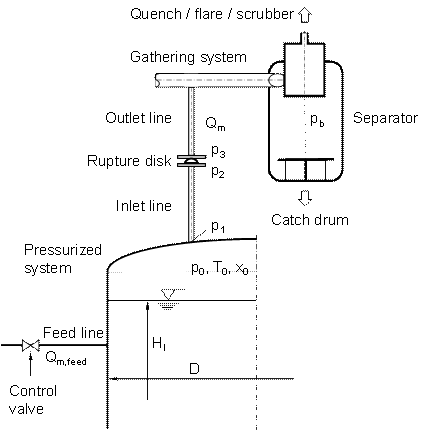

In the chemical and petrochemical industry, vessels and pipes are protected against overpressure with safety relief devices, typically a rupture disk or safety valve. If the device opens due to an undesired deviation from the normal process operation the depressurization lead to a two-phase discharge of the reactor inventory. Typically, a retention system (a cyclone separator or a catch drum) is used to separate the liquid from the two-phase stream, see figure 1. Gases with hazardous properties are e.g. condensed in a quench or burned in a flare. Current regulations to protect the environment led to more complex disposal systems, i.e. larger vent pipes flowing into gathering systems connected to separators, drums, quenches or flares.
A conservative over-sizing of a rupture disk vent pipe may induce a two-phase discharge of the reactor inventory, unexpected large piping forces and a malfunction of the rendition system or flare. Large extra-costs may result and a significant disposal of the environment cannot be excluded. The functioning of the vent systems can only be guaranteed, if precise methods experimentally validated are used for sizing the system. Unfortunately, no standard is available for sizing rupture disk vent lines for flashing two-phase flow. Experimental data are lacking.
In lack of more precise methods, engineers usually size a rupture disk vent line under the assumptions of a homogeneous equilibrium flow through an equivalent nozzle with a strong (unrealistic) flow contraction. The pressure drop in the vent line is often neglected or assumed to be of minor effect. This sizing procedure may lead to several hundred percent deviation from the real flow process. A rupture disk device can arbitrarily be much over- or undersized depending on the actual flow conditions and pipe geometry.
Figure 1: Industrial rupture disk vent line system
The difficulty in sizing a rupture disk vent line for two-phase flashing flow is the interaction with the whole piping system. E.g., if the mass flow rate through the rupture disk is estimated too small, the pressure drop in the inlet and outlet pipe will be underestimated, resulting in a wrong estimation of critical flow areas. Overall, uncertainties in modeling the liquid level swell and, hence, inlet conditions into the piping system, the lack of data for the effective net flow area and flow contraction in the rupture disk as well as uncertainties of the pressure drop estimation in pipes and piping elements may lead to very large differences. In addition, the simulation of the mechanical non-equilibrium (slip) and the thermodynamic non-equilibrium (e.g. boiling delay) in all pipe element produces even more uncertainties. A comparison of these uncertainties will be given in the presentation.
During the last ten years a tremendous effort have been reached by considering phase slip between gases and liquids and thermodynamic non-equilibrium effects leading to highly enlarged mass flow rates through safety valves compared to homogeneous equilibrium calculations. To harmonize the calculation methods for safety valves and rupture disks, the HNEDS model for flashing gas/liquid-two-phase flow through throttling devices, recommended in ISO 4126-10, is extended to the flow through pipes and rupture disks. It includes the thermodynamic non-equilibrium (boiling delay) and may give more representative results compared the any typical homogenous equilibrium model. The method is outlined in detail and example calculations are given to describe the sizing procedure.
The proposed method based on a new general equation for sizing throttling devices and pipes represents the current state of sizing rupture disk devices for two-phase flashing flow. The method is suggested to extend the standards for sizing safety devices.
In future, rupture disk manufacturer need to deliver more detailed data of their rupture disks bursted under in-service conditions. The upcoming ISO-DIS 4126-11 and ASME PTC25 shall be extended to include the necessary test procedures. Testing under single phase laboratory conditions with subcritical almost incompressible gases are not representative for typical industrial applications in the chemical and petrochemical industry. In the presentation the need for more detailed experimental data is outlined.

